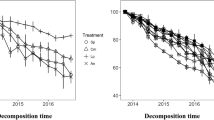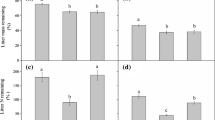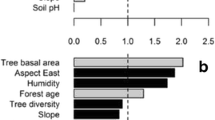Abstract
Aims
Litter chemical properties may be changed by species mixing and consequently affect litter decomposition; however, the effects of species mixing on chemical properties of litter mixtures during decomposition are poorly understood. In this context, we test how changing species diversity may influence the species-mixing effects on chemical properties as well as mass loss of decomposing litter mixtures.
Methods
We assessed the effects of species mixing on C/N ratio, concentrations of N, lignin and polyphenol as well as mass loss of litter mixtures in a Mongolian pine plantation of Northeast China, using a full factorial design containing 15 possible litter combinations of Mongolian pine, Artemisia scoparia, Setaria viridis and Phragmites communis during 182 days of incubation.
Results
In most instances, species mixing produced non-additive effects on mass loss, C/N ratio and release of N and lignin, and additive effects on polyphenol release of litter mixtures. Among the non-additive effects, synergisms were more common than antagonisms, and both of them changed with incubation time. Meanwhile, species composition rather than species richness explained the non-additive effects of species mixing on mass loss, while they both explained the non-additive effects of species mixing on release of N and lignin and C/N ratio of litter mixtures. Furthermore, the coefficients of variation of mass loss significantly decreased with increasing species richness.
Conclusions
Our results suggest that species composition and richness can mediate the decomposition and most chemical properties of mixed-species litter, which are not likely to be accurately predicted from component species decaying alone.





Similar content being viewed by others
References
Ball BA, Hunter MD, Kominoski JS, Swan CM, Bradford MA (2008) Consequences of non-random species loss for decomposition dynamics: experimental evidence for additive and non-additive effects. J Ecol 96:303–313
Ball BA, Bradford AM, Hunter DM (2009) Nitrogen and phosphorus release from mixed litter layers is lower than predicted from single species decay. Ecosystems 12:87–100
Bardgett RD, Freeman C, Ostle NJ (2008) Microbial contributions to climate change through carbon cycle feedbacks. ISME J 2:805–814
Baumann K, Marschner P, Smernik RJ, Baldock JA (2009) Residue chemistry and microbial community structure during decomposition of eucalypt, wheat and vetch residues. Soil Biol Biochem 41:1966–1975
Bonanomi G, Incerti G, Antignani V, Capodilupo M, Mazzoleni S (2010) Decomposition and nutrient dynamics in mixed litter of Mediterranean species. Plant Soil 331:481–496
Bonanomi G, Incerti G, Giannino F, Mingo A, Lanzotti V, Mazzoleni S (2013) Litter quality assessed by solid state 13C NMR spectroscopy predicts decay rate better than C/N and lignin/N ratios. Soil Biol Biochem 56:40–48
Bonanomi G, Capodilupo M, Incerti G, Mazzoleni S (2014) Nitrogen transfer in litter mixture enhances decomposition rate, temperature sensitivity, and C quality changes. Plant Soil 381:307–321
Butchart SH, Walpole M, Collen B, van Strien A, Scharlemann JP, Almond RE, Baillie JE, Bomhard B, Brown C, Bruno J, Carpenter KE, Carr GM, Chanson J, Chenery AM, Csirke J, Davidson NC, Dentener F, Foster M, Galli A, Galloway JN, Genovesi P, Gregory RD, Hockings M, Kapos V, Lamarque JF, Leverington F, Loh J, McGeoch MA, McRae L, Minasyan A, Hernández Morcillo M, Oldfield TE, Pauly D, Quader S, Revenga C, Sauer JR, Skolnik B, Spear D, Stanwell-Smith D, Stuart SN, Symes A, Tierney M, Tyrrell TD, Vié JC, Watson R (2010) Global biodiversity: indicators of recent declines. Science 328:1164–1168
Cardinale BJ, Wright JP, Cadotte MW, Carroll IT, Hector A, Srivastava DS, Loreau M, Weis JJ (2007) Impacts of plant diversity on biomass production increase through time because of species complementarity. PNAS 104:18123–18128
Cebrian J (1999) Patterns in the fate of production in plant communities. Am Nat 154:449–468
Chapman SK, Koch GW (2007) What type of diversity yields synergy during mixed litter decomposition in a natural forest ecosystem? Plant Soil 299:153–162
Chen FS, Zeng DH, Zhou B, Singh AN, Fan ZP (2006) Seasonal variation in soil nitrogen availability under Mongolian pine plantations at the Keerqin Sand Lands, China. J Arid Environ 67:226–239
Cornwell WK, Cornelissen JHC, Amatangelo K, Dorrepaal E, Eviner VT, Godoy O, Hobbie SE, Hoorens B (2008) Plant species traits are the predominant control on litter decomposition rates within biomes worldwide. Ecol Lett 11:1065–1071
Cuchietti A, Marcotti E, Gurvich DE, Cingolani AM, Pérez Harguindeguy N (2014) Leaf litter mixtures and neighbour effects: low-nitrogen and high-lignin species increase decomposition rate of high-nitrogen and low-lignin neighbours. Appl Soil Ecol 82:44–51
Dang CK, Chauvet E, Gessner MO (2005) Magnitude and variability of process rates in fungal diversity–litter decomposition relationships. Ecol Lett 8:1129–1137
Day KJ, John EA, Hutchings MJ (2003) The effects of spatially heterogeneous nutrient supply on yield, intensity of competition and root placement patterns in Briza media and Festuca ovina. Funct Ecol 17:454–463
De Marco A, Meola A, Maisto G, Giordano M, Santo AVD (2011) Non-additive effects of litter mixtures on decomposition of leaf litters in a Mediterranean maquis. Plant Soil 344:305–317
Doak DF, Bigger D, Harding EK, Marvier MA, Malley REO, Thomson D (1998) The statistical inevitability of stability–diversity relationships in community ecology. Am Nat 151:264–276
Gartner TB, Cardon ZG (2004) Decomposition dynamics in mixed-species leaf litter. Oikos 104:230–246
Giesselmann UC, Martins KG, Braendle M (2010) Diversity and ecosystem functioning: litter decomposition dynamics in the Atlantic rainforest. Appl Soil Ecol 46:283–290
Hättenschwiler S, Gasser P (2005) Soil animals alter plant litter diversity effects on decomposition. PNAS 102:1519–1524
Hättenschwiler S, Vitousek PM (2000) The role of polyphenols in terrestrial ecosystem nutrient cycling. Trends Ecol Evol 15:238–243
Hättenschwiler S, Tiunov AV, Scheu S (2005) Biodiversity and litter decomposition in terrestrial ecosystems. Annu Rev Ecol Syst 36:191–218
Hättenschwiler S, Coq S, Barantal S, Handa IT (2011) Leaf traits and decomposition in tropical rainforests: revisiting some commonly held views and towards a new hypothesis. New Phytol 189:950–965
Heal OW, Anderson JM, Swift MJ (1997) Plant litter quality and decomposition: an historical overview. In: Cadisch G, Giller KE (eds) Driven by nature: plant litter quality and decomposition. CAB Int, Wallingford, pp 3–30
Hector A, Beale AJ, Minns A, Otway SJ, Lawton JH (2000) Consequences of the reduction of plant diversity for litter decomposition: effects through litter quality and microenvironment. Oikos 90:357–371
Hoorens B, Aerts R, Stroetenga M (2003) Does initial litter chemistry explain litter mixture effects on decomposition? Oecologia 137:578–586
Iiyama K, Wallis AFA (1990) Determination of lignin in herbaceous plants by an improved acetyl bromide procedure. J Sci Food Agric 51:145–161
Jacob M, Viedenz K, Polle A, Thomas FM (2010) Leaf litter decomposition in temperate deciduous forest stands with a decreasing fraction of beech (Fagus sylvatica). Oecologia 164:1083–1094
Keith AM, Van der Wal R, Brooker RW, Osler GHR, Chapman SJ, Burslem DFRP, Elston DA (2008) Increasing litter species richness reduces variability in a terrestrial decomposer system. Ecology 89:2657–2664
Kominoski JS, Pringle CM, Ball BA, Bradford MA, Coleman DC, Hall DB, Hunter MD (2007) Nonadditive effects of leaf litter species diversity on breakdown dynamics in a detritus-based stream. Ecology 88:1167–1176
Larsen TH, Williams NM, Kremen C (2005) Extinction order and altered community structure rapidly disrupt ecosystem functioning. Ecol Lett 8:538–547
Lecerf A, Risnoveanu G, Popescu C, Gessner MO, Chauvet E (2007) Decomposition of diverse litter combinations in streams. Ecology 88:219–227
Lecerf A, Marie G, Kominoski JS, LeRoy CJ, Bernadet C, Swan CM (2011) Incubation time, functional litter diversity, and habitat characteristics predict litter-mixing effects on decomposition. Ecology 92:160–169
Loreau M, Naeem S, Inchausti P, Bengtsson J, Grime JP, Hector A, Hooper DU, Huston MA, Raffaelli D, Schmid B, Tilman D, Wardle DA (2001) Biodiversity and ecosystem functioning: current knowledge and future challenges. Science 294:804–808
Mao R, Zeng DH (2012) Non-additive effects vary with the number of component residues and their mixing proportions during residue mixture decomposition: a microcosm study. Geoderma 170:112–117
Marquard E, Weigelt A, Temperton VM, Roscher C, Schumacher J, Buchmann N, Fischer M, Weisser WW, Schmid B (2009) Plant species richness and functional composition drive overyielding in a six-year grassland experiment. Ecology 90:3290–3302
McCann KS (2000) The diversity–stability debate. Nature 405:228–233
Meier CL, Bowman WD (2008) Links between plant litter chemistry, species diversity, and below-ground ecosystem function. PNAS 105:19780–19785
Meier CL, Bowman WD (2010) Chemical composition and diversity influence non-additive effects of litter mixures on soil carbon and nitrogen cycling: implications for plant spcies loss. Soil Biol Biochem 42:1447–1454
Moore JC, Berlow EL, Coleman DC, Ruiter PC, Dong Q, Hastings A, Johnson NC, McCann KS, Melville K, Morin PJ, Nadelhoffer K, Rosemond AD, Post DM, Sabo JL, Scow KM, Vanni MJ, Wall DH (2004) Detritus, trophic dynamics and biodiversity. Ecol Lett 7:584–600
Nelson DW, Sommers LE (1996) Total carbon, organic carbon and organic matter. In: Sparks DL, Page AL, Helmke PA, Loeppert RH, Soltanpour PN, Tabatabai MA, Johnston CT, Sumner ME (eds) Methods of soil analysis, part 3: chemical methods. Soil Science Society of America, Wisconsin, pp 961–1010
Petchey OL, Gaston KJ (2002) Extinction and the loss of functional diversity. P Roy Soc Long B Bio 269:1721–1727
Prescott CE, Chappell HN, Vesterdal L (2000) Nitrogen turnover in forest floors of coastal Douglas fir at sites differing in soil nitrogen capital. Ecology 81:1878–1887
Quested HM, Press MC, Callaghan TV, Cornelissen JHC (2002) The hemiparasitic angiosperm Bartsia alpina has the potential to accelerate decomposition in subarctic communities. Oecologia 130:88–95
Sala OE, Chapin FS III, Armesto JJ, Berlow E, Bloomfield J, Dirzo R, Huber-Sanwald E, Huenneke LF, Jackson RB, Kinzig A, Leemans R, Lodge DM, Mooney HA, Oesterheld M, Poff NL, Sykes MT, Walker BH, Walker M, Wall DH (2000) Global Biodiversity Scenarios for the Year 2100. Science 287:1170–1774
Salamanca EF, Kaneko N, Katagiri S (1998) Effects of leaf litter mixtures on the decomposition of Quercus serrata and Pinus densiflora using field and laboratory microcosm methods. Ecol Eng 10:53–73
Schmidt MWI, Torn MS, Abiven S, Dittmar T, Guggenberger G, Janssens IA, Kleber M, Kögel-Knabner I, Lehmann J, Manning DAC, Nannipieri P, Rasse DP, Weiner S, Trumbore SE (2011) Persistence of soil organic matter as an ecosystem property. Nature 478:49–56
Schnitzer M, Monreal CM (2011) Quo vadis soil organic matter research? a biological link to the chemistry of humification. Adv Agron 113:139–213
Suding KN, Miller AE, Bechtold H, Bowman WD (2006) The consequence of species loss on ecosystem nitrogen cycling depends on community compensation. Oecologia 149:141–149
Tilman D, Reich PB, Knops JM (2006) Biodiversity and ecosystem stability in a decade-long grassland experiment. Nature 441:629–632
Toljander YK, Lindahl BD, Holmer L, Högberg NOS (2006) Environmental fluctuations facilitate species co-existence and increase decomposition in communities of wood decay fungi. Oecologia 148:625–631
Vitousek PM, Aber JD, Howarth RW, Likens GE, Matson PA, Schindler DW, Schlesinger WH, Tilman DG (1997) Human alteration of the global nitrogen cycle: sources and consequences. Ecol Appl 7:737–750
Wardle DA, Bonner KI, Nicholson KS (1997) Biodiversity and plant litter: experimental evidence which does not support the view that enhanced species richness improves ecosystem function. Oikos 79:247–258
Wardle DA, Yeates GW, Barker GM, Bonner KI (2006) The influence of plant litter diversity on decomposer abundance and diversity. Soil Biol Biochem 38:1052–1062
Waterman PG, Mole S (1994) Analysis of phenolic plant metabolites. The Methods in Ecology Series. Oxford: Blackwell Scientific Publications, 238 pp
Wickings K, Grandy AS, Reed SC, Cleveland CC (2012) The origin of litter chemical complexity during decomposition. Ecol Lett 15:1180–1188
Wu DD, Li TT, Wan SQ (2013) Time and litter species composition affect litter-mixing effects on decomposition rates. Plant Soil 371:355–366
Zeng DH, Hu YL, Chang SX, Fan ZP (2009) Land cover change effects on soil chemical and biological properties after planting Mongolian pine (Pinus sylvestris var. mongolica) in sandy lands in Keerqin, northeastern China. Plant Soil 317:121–133
Acknowledgments
This work was supported by the National Natural Science Foundation of China (31270668) and the State Key Laboratory of Forest and Soil Ecology (LFSE2013-11). We thank Gui-Yan Ai and **g-Shi Li for their technical assistance, and two anonymous referees for their valuable comments and suggestions that greatly improved the manuscript.
Author information
Authors and Affiliations
Corresponding author
Additional information
Responsible Editor: Alfonso Escudero.
Electronic supplementary material
Below is the link to the electronic supplementary material.
Appendix A
(DOC 161 kb)
Appendix B
(DOC 337 kb)
Appendix C
(DOC 325 kb)
Appendix D
(DOC 161 kb)
Appendix E
(DOC 163 kb)
Rights and permissions
About this article
Cite this article
Mao, B., Yu, ZY. & Zeng, DH. Non-additive effects of species mixing on litter mass loss and chemical properties in a Mongolian pine plantation of Northeast China. Plant Soil 396, 339–351 (2015). https://doi.org/10.1007/s11104-015-2593-3
Received:
Accepted:
Published:
Issue Date:
DOI: https://doi.org/10.1007/s11104-015-2593-3




